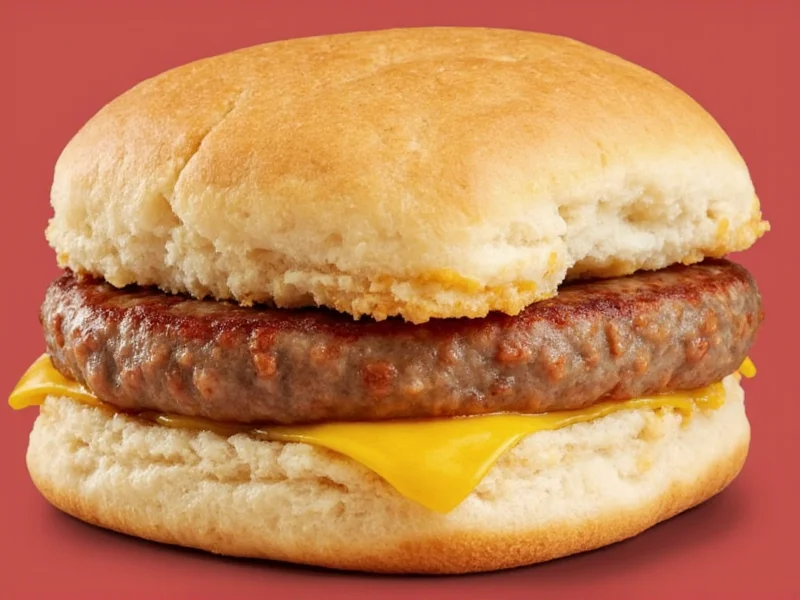When tracking your daily nutritional intake, understanding the exact calorie content of fast food menu items is essential. The McDonald's Sausage Biscuit remains one of the chain's most popular breakfast offerings, and its nutritional profile matters to health-conscious consumers and those monitoring their dietary habits.
Nutritional Profile of McDonald's Sausage Biscuit
The complete nutritional breakdown provides valuable context beyond just the calorie count. This information comes directly from McDonald's official nutrition facts database, last updated in early 2023.
| Nutrient | Amount | % Daily Value* |
|---|---|---|
| Calories | 460 | 23% |
| Total Fat | 32g | 41% |
| Saturated Fat | 12g | 60% |
| Trans Fat | 0.5g | - |
| Cholesterol | 95mg | 32% |
| Sodium | 1110mg | 48% |
| Total Carbohydrates | 29g | 11% |
| Dietary Fiber | 1g | 4% |
| Sugars | 2g | - |
| Protein | 15g | - |
*Percent Daily Values are based on a 2,000 calorie diet. Your daily values may be higher or lower depending on your calorie needs.
Understanding the Calorie Composition
The 460 calories in a McDonald's Sausage Biscuit come primarily from its two main components. The sausage patty contributes approximately 300 calories, while the biscuit itself accounts for about 160 calories. This distribution explains why the item is relatively high in both fat and carbohydrates.
For those monitoring specific dietary components, it's worth noting that nearly 60% of the daily recommended limit for saturated fat comes from this single menu item. The sodium content also represents nearly half of what health organizations recommend for an entire day.
Menu Variations and Calorie Differences
McDonald's offers several variations of their sausage biscuit that affect the total calorie count:
- Sausage Biscuit with Egg: 550 calories (adds approximately 90 calories for the egg)
- Sausage McGriddle: 530 calories (substitutes the biscuit for sweet maple-flavored griddle cakes)
- Sausage Biscuit without Sausage: 290 calories (biscuit only)
These alternatives provide options for those seeking to modify their calorie intake while still enjoying similar flavor profiles. The Sausage McGriddle, while only slightly higher in calories than the standard sausage biscuit, contains significantly more sugar due to the maple-flavored cakes.
Dietary Context and Considerations
For individuals following standard 2,000-calorie diets, the McDonald's Sausage Biscuit represents about 23% of daily caloric needs. This makes it a substantial breakfast option that should be considered within the context of your entire day's eating pattern.
Nutritionists often recommend that breakfast should provide 20-25% of your daily calories, placing this item at the higher end of that range. The high saturated fat and sodium content means it's best consumed occasionally rather than as a daily breakfast staple, especially for those with cardiovascular concerns.
When comparing fast food breakfast options, the sausage biscuit sits in the mid-to-high range for calorie content. It contains fewer calories than many breakfast sandwiches with multiple meat options or those featuring cheese, but more than simpler options like a plain bagel or English muffin.
Practical Tips for Health-Conscious Consumers
If you're watching your calorie intake but still want to enjoy a McDonald's breakfast, consider these practical adjustments:
- Order the biscuit without the sausage for a 290-calorie option
- Pair your sausage biscuit with black coffee or water instead of sugary beverages
- Consider splitting the sandwich if you're sensitive to high-fat foods
- Balance this higher-calorie breakfast with lighter meals later in the day
- Check for regional variations, as some international locations may have different nutritional profiles
Remember that nutritional information can vary slightly based on preparation methods and specific ingredients used at different locations. The 460-calorie figure represents the standard preparation as documented in McDonald's official nutrition guide.
How This Compares to Homemade Alternatives
For those interested in preparing similar items at home, a homemade sausage biscuit can potentially be lower in calories with careful ingredient selection. Using leaner sausage (approximately 180 calories) and a reduced-fat biscuit (about 150 calories) could bring the total down to around 330 calories while maintaining similar portion sizes.
However, convenience remains a significant factor for most consumers choosing fast food breakfast options. The trade-off between convenience and nutritional profile is an important consideration when making regular dining decisions.











 浙公网安备
33010002000092号
浙公网安备
33010002000092号 浙B2-20120091-4
浙B2-20120091-4